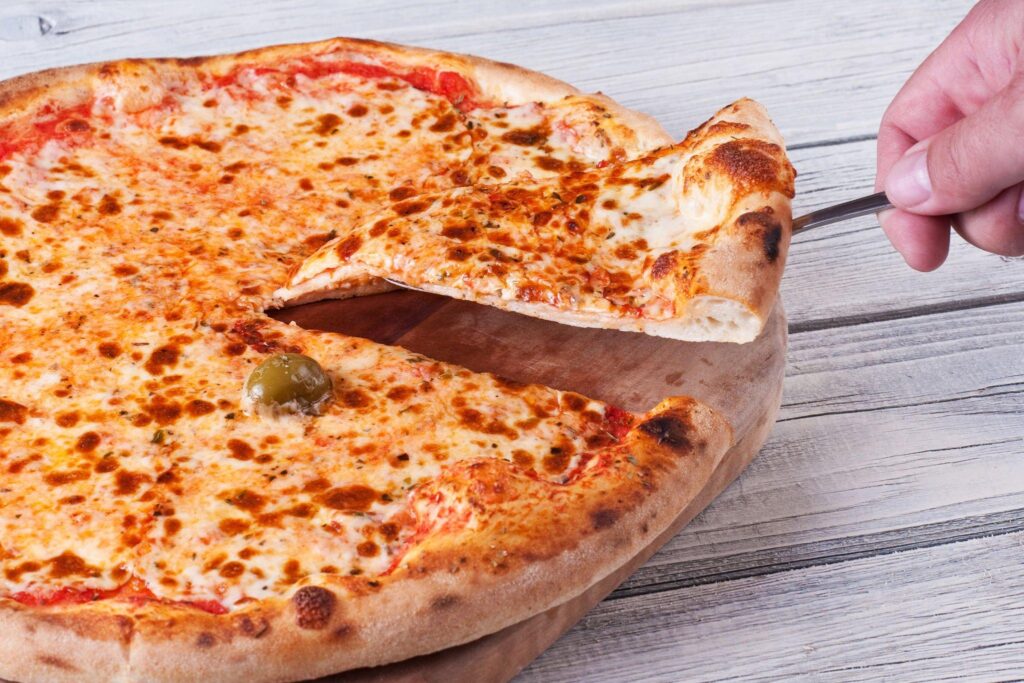Introduction
Pizza is a beloved food that has become a staple in many people’s diets. Its combination of flavors, versatility, and convenience make it a popular choice for meals and snacks. However, for individuals with ulcerative colitis, a chronic inflammatory bowel disease, dietary choices can be more challenging. In this article, we will explore whether you can eat pizza with ulcerative colitis. And ulcerative colitis, and whether it is safe to consume pizza with this condition.
Why Pizza Is A Popular Food Choice?
Pizza has gained immense popularity worldwide due to its delicious taste and wide variety of options. It offers a combination of flavors from its crispy crust, savory sauce, melty cheese, and various toppings, allowing individuals to customize their slices according to their preferences. Additionally, pizza can be easily found at restaurants, delivered to your doorstep, or made at home using pre-made or homemade dough. Its convenience, versatility, and social appeal make it a go-to choice for gatherings, parties, and even quick meals.
The Link Between Ulcerative Colitis And Diet
Ulcerative colitis is a type of inflammatory bowel disease that causes inflammation and ulcers in the colon and rectum. While the exact cause of this condition is unknown, diet is known to play a role in managing symptoms and reducing flare-ups. People with ulcerative colitis often experience abdominal pain, diarrhea, rectal bleeding, and weight loss. Certain foods can trigger these symptoms and worsen the condition.
For individuals with ulcerative colitis, it is essential to follow a well-balanced diet that avoids known trigger foods. These triggers can vary from person to person, but common culprits include spicy foods, fatty foods, caffeine, alcohol, and high-fiber foods. The goal is to identify and eliminate these triggers to minimize symptoms and maintain remission.
When it comes to pizza, its components can potentially trigger symptoms in individuals with ulcerative colitis. The high-fat content, especially from greasy toppings like pepperoni or sausage, can be problematic for those with sensitive digestive systems. The cheese and tomato sauce may also cause issues for some people due to high acidity or lactose intolerance. Additionally, the high carbohydrate content in the crust can contribute to bloating and gas.
Individuals with ulcerative colitis must listen to their bodies and pay attention to how certain foods, including pizza, affect their symptoms. Some may find that they can enjoy pizza in moderation, while others may need to avoid or modify certain ingredients to make it more suitable for their condition. Consulting with a healthcare professional or registered dietitian can provide personalized guidance and recommendations based on individual needs.
In conclusion, individuals with ulcerative colitis should approach their diet with caution and be aware of potential trigger foods. While pizza is a popular and delicious food choice, its high-fat, high-acid, and high-carbohydrate components may not be well-tolerated by everyone with this condition. It is essential to listen to your body and work closely with healthcare professionals to create a dietary plan that supports your overall health and manages symptoms effectively.
Understanding Ulcerative Colitis
Definition And Symptoms Of Ulcerative Colitis
Ulcerative colitis is a chronic inflammatory bowel disease that primarily affects the colon and rectum. It is characterized by inflammation and ulcers in the lining of the large intestine, leading to symptoms such as abdominal pain, diarrhea, rectal bleeding, and urgency to have bowel movements. Some individuals may also experience fatigue, weight loss, and loss of appetite.
This condition is believed to be caused by an abnormal immune response in the body, although the exact cause is still unknown. It can occur at any age, but it most commonly begins between the ages of 15 and 30.
The Impact Of Diet On Ulcerative Colitis Symptoms
While diet alone cannot cure ulcerative colitis, it can play a significant role in managing symptoms and reducing flare-ups. Different individuals may have different trigger foods that worsen their symptoms. However, there are some general dietary guidelines that can help alleviate symptoms for many people with ulcerative colitis:
- Low-residue diet: This involves avoiding high-fiber foods, such as nuts, seeds, whole grains, and raw fruits and vegetables. These foods can be harder to digest and may exacerbate symptoms like diarrhea and abdominal pain.
- Dairy and lactose avoidance: Many individuals with ulcerative colitis may have trouble digesting lactose, the sugar found in milk and dairy products. Avoiding or limiting dairy products can help reduce symptoms like bloating and diarrhea.
- Avoiding trigger foods: Certain foods may trigger or worsen symptoms in some individuals, such as spicy foods, caffeine, alcohol, and fatty or greasy foods. Keeping a food diary and identifying personal trigger foods can be helpful.
- Small, frequent meals: Eating smaller meals throughout the day can be easier on the digestive system, reducing symptoms like bloating and discomfort.
- Staying hydrated: Drinking enough water is important for everyone, but it is especially crucial for individuals with ulcerative colitis. It helps maintain proper hydration and can ease symptoms like constipation.
It is essential for individuals with ulcerative colitis to work closely with a healthcare professional, such as a gastroenterologist or a registered dietitian, to develop a personalized diet plan that suits their specific needs and helps manage their symptoms.
Overall, while pizza can be a delicious treat, it may not be the best choice for individuals with ulcerative colitis. The high fat content, the potential for triggering symptoms like abdominal pain and diarrhea, and the presence of ingredients like cheese and tomato sauce that may worsen symptoms for some individuals make it a food to approach with caution. However, each person’s response to pizza may vary, and it is best to consult with a healthcare professional to determine what is appropriate for your individual condition.
Can You Eat Pizza With Ulcerative Colitis?
Ulcerative colitis is a chronic inflammatory bowel disease that involves inflammation in the colon and rectum. It can cause symptoms like abdominal pain, diarrhea, and rectal bleeding. If you have ulcerative colitis, you may wonder if you can still enjoy your favorite foods, like pizza. Here are some factors to consider when eating pizza with ulcerative colitis and tips for making it more ulcerative colitis-friendly.
Factors To Consider When Eating Pizza With Ulcerative Colitis
- Crust: The type of crust can make a difference. Opt for thin-crust or gluten-free options if you have trouble digesting wheat or if gluten triggers your symptoms. Whole wheat crust may be a healthier choice for some individuals as it contains more fiber.
- Toppings: Certain pizza toppings can be problematic for people with ulcerative colitis. Spicy ingredients like jalapenos or hot sauce may exacerbate inflammation in the digestive tract. Greasy toppings like pepperoni or sausage can also be harder to digest. It’s best to choose milder toppings like vegetables, chicken, or seafood.
- Cheese: Some individuals with ulcerative colitis may have lactose intolerance, which can cause digestive discomfort. If you have issues with dairy, consider opting for lactose-free cheese or alternative cheeses made from nuts or soy.
- Sauces: Tomato-based sauces can be acidic and may worsen symptoms in some individuals. Consider trying pizza with alternative sauces like pesto or olive oil if you find tomato-based sauces bothersome.
Tips For Making Pizza More Ulcerative Colitis-friendly
- Home Cooking: Making pizza at home allows you to have full control over the ingredients. You can choose ulcerative colitis-friendly toppings, use alternative crusts, and experiment with sauces that suit your preferences and tolerance.
- Portion Control: Moderation is key. Limiting portion sizes can help prevent overeating, reduce the risk of triggering symptoms, and ensure you’re getting a balanced diet.
- Pair with Digestible Sides: Consider pairing your pizza with a side of steamed vegetables or a light salad. This can help add more nutrition and make the overall meal more ulcerative colitis-friendly.
- Listen to Your Body: Everyone’s tolerance to certain foods can vary. Pay attention to how your body reacts to different ingredients or combinations and adjust your choices accordingly. Keeping a food diary can help identify trigger foods and make informed dietary choices.
It’s important to note that while these tips may help make pizza more ulcerative colitis-friendly, it’s always best to consult with a healthcare professional or registered dietitian for personalized advice that takes into account your specific dietary needs and symptoms.
Remember, managing ulcerative colitis involves a holistic approach that includes medication, lifestyle changes, and a well-balanced diet. By making informed choices and listening to your body, you can still enjoy a slice of pizza while taking care of your health.
Alternative Pizza Options For Ulcerative Colitis
If you have been diagnosed with ulcerative colitis, you may be wondering if you can still enjoy pizza without triggering symptoms. While traditional pizza can be problematic for individuals with this condition, there are alternative options available that can satisfy your pizza cravings while being easier on your digestive system. In this article, we will explore healthier pizza choices for ulcerative colitis patients, as well as recipes and ingredients to consider for a digestion-friendly pizza.
Exploring Healthier Pizza Choices For Ulcerative Colitis Patients
When it comes to ulcerative colitis, certain ingredients can exacerbate symptoms, such as inflammation and diarrhea. Here are some alternative pizza choices that can help minimize these issues:
- Cauliflower Crust Pizza: Replace traditional wheat-based crust with a cauliflower crust. Cauliflower is low in fiber and gluten-free. You can make your own cauliflower crust or find pre-made options in stores.
- Gluten-Free Crust: If you prefer a more traditional crust, opt for gluten-free alternatives made from rice flour, almond flour, or potato flour. These options are easier to digest for many ulcerative colitis patients.
- Veggie-Based Pizza: Load your pizza with a variety of vegetables. Vegetables such as spinach, bell peppers, zucchini, and tomatoes provide essential nutrients while being gentle on the digestive system.
Recipes And Ingredients To Consider For A Digestion-friendly Pizza
Creating a digestion-friendly pizza involves choosing ingredients that are low in fiber, easy to digest, and gentle on the gut. Here are some recipe ideas and ingredients to consider:
- White Sauce Pizza: Instead of using tomato sauce, try a white sauce made from low-fat Greek yogurt or a mild cheese like mozzarella. These alternatives are less acidic and generally well-tolerated.
- Lean Protein Toppings: Opt for lean proteins like grilled chicken, turkey, or seafood instead of high-fat meats like sausage or pepperoni. This helps minimize the risk of triggering inflammation.
- Mild Spices: Use mild spices such as oregano, basil, or thyme for flavor rather than spicy options that can irritate the digestive system.
Remember to consult with your healthcare provider or a registered dietitian before making any significant changes to your diet. They can provide personalized recommendations based on your specific condition and needs.
By exploring alternative pizza options and choosing digestion-friendly ingredients, you can still enjoy pizza while managing your ulcerative colitis symptoms. Experiment with different recipes and ingredients to find what works best for you and make pizza nights an enjoyable and comfortable experience.
Expert Insights And Recommendations
Expert Opinions On Eating Pizza With Ulcerative Colitis
When it comes to managing ulcerative colitis, it is essential to consider your diet and make choices that promote gut health. Pizza, being a popular and delicious food choice, may raise concerns for individuals with ulcerative colitis. Here are some expert insights on whether it is possible to enjoy pizza without aggravating symptoms:
- Dr. Samantha Nazareth, a gastroenterologist, suggests that pizza can be problematic for individuals with ulcerative colitis due to its high-fat content, the potential for triggering inflammation, and ingredients like cheese and gluten that might be difficult for some people to digest.
- On the other hand, registered dietitian Bethany Frazier believes that it is possible to enjoy pizza with ulcerative colitis by making some modifications. Opting for a thin-crust pizza, avoiding high-fat toppings like pepperoni or sausage, and incorporating more vegetables as toppings can help reduce the risk of triggering symptoms.
- According to the Crohn’s & Colitis Foundation, it is important to listen to your body and identify which specific ingredients or types of pizza trigger symptoms. They recommend keeping a food diary to track your reactions and consulting with a healthcare professional or registered dietitian for personalized advice.
Tips For Managing Ulcerative Colitis Symptoms While Enjoying Pizza
While it may be possible to enjoy pizza with ulcerative colitis, it is crucial to be mindful of your symptoms and make choices that support your gut health. Here are some tips to consider:
- Opt for a thin crust: Thin crust pizzas tend to be lower in fat and easier to digest compared to thick or deep-dish crusts. This can help reduce the strain on your digestive system.
- Choose low-fat toppings: Avoid high-fat toppings like pepperoni, sausage, or extra cheese. Opt for healthier options such as grilled chicken, vegetables, or plant-based alternatives.
- Consider gluten-free alternatives: If you have a sensitivity to gluten, explore gluten-free pizza crust options or cauliflower crusts that are easier on the digestive system.
- Load up on veggies: Adding a variety of vegetables as pizza toppings can increase the fiber content and provide essential nutrients while reducing the overall fat and calorie content.
- Practice portion control: Enjoy pizza in moderation and pay attention to portion sizes. Overeating can put added stress on your digestive system.
- Stay hydrated: Drink plenty of water before, during, and after eating pizza to help with digestion and prevent dehydration.
It is important to note that individual experiences with ulcerative colitis may vary. It is always advisable to consult with your healthcare provider or a registered dietitian before making any significant changes to your diet or trying new foods.
FAQ about Pizza and Health: Can You Eat Pizza with Ulcerative Colitis?
Q: What is ulcerative colitis?
A: Ulcerative colitis is an autoimmune disease that affects the large intestine.
Q: Can you eat pizza with ulcerative colitis?
A: Yes, you can eat pizza with ulcerative colitis, but it is generally recommended to avoid it due to the potential for stomach upset.
Q: What are some tips for eating pizza with ulcerative colitis?
A: Here are a few tips:
- Choose whole-grain crusts or those made with gluten-free flour.
- Ask for pizza with minimal or no added cheese.
- Avoid pizza with ingredients that may trigger symptoms, such as tomatoes or spices.
Q: Is dairy a concern when it comes to pizza and ulcerative colitis?
A: Dairy products, including cheese, can be a trigger for some people with ulcerative colitis. It is advisable to opt for pizzas with minimal or no added cheese or explore dairy-free alternatives like vegan cheese.
Q: Can gluten in pizza crust affect ulcerative colitis symptoms?
A: Gluten can be a trigger for individuals with autoimmune conditions like ulcerative colitis. Choosing gluten-free pizza crusts or those made with alternative flours may be a better option for those sensitive to gluten.
Q: Are there any other ingredients in pizza that can aggravate ulcerative colitis symptoms?
A: Yes, some individuals with ulcerative colitis report that ingredients like tomatoes and spices can trigger symptoms. It is advisable to avoid these ingredients or customize your pizza to suit your needs.
Q: Can you enjoy pizza with ulcerative colitis at home?
A: Yes, you can make your own pizza at home using alternative ingredients that suit your dietary restrictions and preferences. This allows you more control over the ingredients and can help minimize any potential triggers.
Q: Is it okay to indulge in conventional pizza with ulcerative colitis on special occasions?
A: While it is technically possible to indulge in conventional pizza on very special occasions, it is generally not recommended due to the potential for triggering symptoms. Opting for alternative options or homemade versions would be a healthier choice.
Conclusion
In conclusion, branding is a fundamental aspect of any business that cannot be overlooked. It plays a crucial role in distinguishing your business from competitors and making it more recognizable to your target audience. By showcasing your unique values, story, brand promise, and other assets, you can create a point of difference that sets you apart in a crowded marketplace. Investing in a consistent branding effort not only helps to make your brand more memorable but also fosters trust among your customers, influencing their buying decisions and engagement with your content.
Summary Of Key Points Discussed
- Branding is essential for businesses of all sizes to stay relevant and stand out from their competitors.
- Creating a distinctive brand identity goes beyond designing a logo and slogan; it involves showcasing your values, story, and brand promise.
- Investing in consistent branding efforts helps make your brand more memorable to customers.
- Brand recognition fosters trust, influencing customers’ buying decisions and engagement with your content, emails, or ads.
Final Thoughts On Branding
Branding is not something to be overlooked or taken lightly in today’s competitive business landscape. By investing time and effort into creating a unique brand identity and consistently communicating your values and promises, you can differentiate your business from the competition and build a strong emotional connection with your target audience. Look to successful brands like Apple, Nike, and Coca-Cola for inspiration and guidance on how to effectively utilize branding to create a lasting impact. Remember, branding is an ongoing process, so continue to evaluate and refine your brand strategy to ensure it aligns with your business goals and resonates with your customers.

Looking for delicious pizza and authentic Italian cuisine? Look no further than Claudia R. Diaz at Joe’s NY Pizza in Tonawanda! Our menu features a wide variety of classic dishes and innovative creations, all made with the freshest ingredients and prepared with the utmost care. Whether you’re in the mood for a traditional Margherita pizza or something a little more adventurous, like our Buffalo chicken pizza or shrimp scampi pasta, Claudia R. Diaz has something to satisfy every craving. So why wait? Visit us today and experience the best Italian food in Tonawanda! #ClaudiaRDiaz #JoesNYPizzaTonawanda #ItalianFood #PizzaLovers #FoodiesUnite



